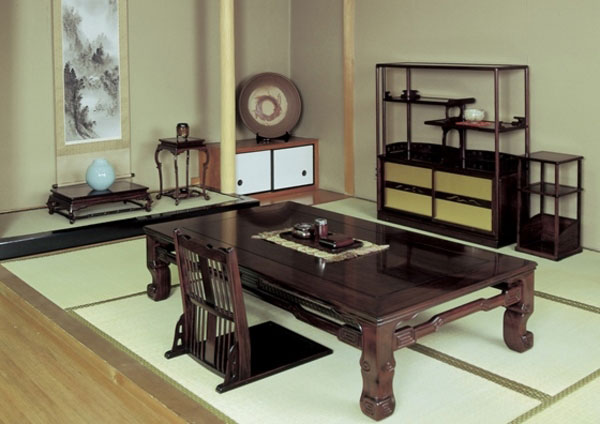 Photo:Osaka Prefecture
Photo:Osaka Prefecture
- Wood, bamboo crafts
- Osaka
Osaka karaki wood joinery Osaka karaki sashimono
Karaki wood ideal for our modern life
Craft that gets deeper with age
Description
What is Osaka karaki wood joinery ?
Osaka Karaki Wood Joinery, called Osaka Karaki Sashimono in Japanese, are wooden articles manufactured in several cities of Osaka Prefecture. Karaki is wood from trees mainly grown in Southeast Asia, and include rosewood, ebony, Chinese quince, and Bombay black wood. Sashimono (joinery) is a woodworking technique for assembly without using nails or screws. Planks are joined by combining mortises and tenons. Karaki Sashimono artisans and merchants that settled in Osaka in the Edo Period when the city was a bustling center of commerce established the history and tradition of Karaki Sashimono in the region. Osaka Karaki Sashimono are characterized by their shiny solid and attractive colors and urushi lacquer surfaces as smooth as a mirror. Today, furniture made with the traditional techniques still match well with modern interior, and products range from cabinets and tea shelves to tables, such as Japanese low tables and vase stands, as well as very small items, like chopsticks and small boxes.
History
In the Nara Period (710 - 794), products brought back to Japan by the Japanese missions to Tang-dynasty China included those made of rare wood that had never been seen in Japan. These products were called karaki and are said to be the origin of Osaka Karaki Sashimono. In the Azuchi-Momoyama Period (1560 - 1600), the use of karaki items increased in parallel with the emergence of the Japanese arts of tea ceremony and flower arrangement. Due to the inconvenience of shoin zukuri style (a traditional style of Japanese residential architecture) built-in two-level shelves and desks, the demand for portable furniture increased. Joinery artisans evolved from among carpenters, and professional joiners appeared as the number of types of sashimono (joinery) increased, until joinery was established as a profession in the Genroku era (1688 - 1704). During the Edo Period (1603 - 1838) , Osaka became a thriving center of commerce, and karaki wood imported to Nagasaki was transported to Osaka. Since pharmaceutical wholesalers in Osaka were selling karaki wood cabinets, a guild of joiners was established, which led to an increase in the number of artisans, and Osaka Karaki Sashimono was established as a craftwork of Osaka. At present, as a traditional art craft with a history of 300 years, Osaka Karaki Sashimono has been certified as a traditional craft by the Minister of Economy, Trade and Industry.
General Production Process
- 1. Sawing wood As the quality of the product depends on the quallity of wood, the selection of wood is extremely important. Since karaki wood is very hard, it can only be sawn in a sawmill specializing in such work. Logs are assessed and sawn one by one, with much care taken in order not to crack the core.
- 2. Drying The wood is naturally dried indoors for five to six years.
- 3. Preparing the Timber The thoroughly dried wood is cut roughly to size, including an allowance for errors.
- 4. Planing The roughly cut materials are planed to an accurate thickness. Detailed sections and curved and joined sections are finished with planes set with a variety of angles.
- 5. Marking in white White lines are drawn with a blade on the planed surface for later processes.
- 6. Cutting the joints Mortises and tenons are cut out with a chisel and finished with a wood file.
- 7. Polishing The materials are polished with water and water-resistant sand paper.
- 8. Forming The sections to be joined are finished.
- 9. Coloring The wood is colored with dyes, such as sappan dye and black-tooth dye.
- 10. Assembly Components are assembled and glued with animal glue or wood glue.
- 11. Lacquering Naturally purified raw lacquer is evenly rubbed in to give the product a beautiful finish.
Where to Buy & More Information
Japan Folk Art Museum
-
Address
-
Tel.+81-6-6641-6309
-
ClosedMonday, 2nd Tuesday of the month, around the New Year
-
Business Hours10am to 5pm
-
Website
See more Wood, bamboo crafts
- Hakone wood mosaic
- Iwayado traditional chest
- Kaba cherrybark woodcrafts
- Odate bentwood
- Inami wood carvings
- Matsumoto furniture
- Beppu bamboo crafts
- Edo wood joinery
- Ichii woodcarvings
- Suruga bamboo crafts
- Edo bamboo fishing rods
- Kishu bamboo fishing rods
- Kamo traditional chest
- Kyo wood joinery
- Miyakonojo archery bows
- Osaka carved wooden panel
- Miyajima woodwork
- Nibutani carved wooden tray
- Okuaizu Basketry
- Echizen traditional chest
- Kasukabe traditional paulownia chest
- Katsuyama bamboo crafts
- Osaka karaki wood joinery
- Takayama tea whisks
- Toyooka wicker crafts
- Akita cedar tubs and barrels
- Nagiso woodturning
- Kishu traditional chest
- Nagoya traditional paulownia chest
- Osaka bamboo screens
- Osaka-senshu traditional paulownia chest
- Sendai traditional chest































































































































































































































































































